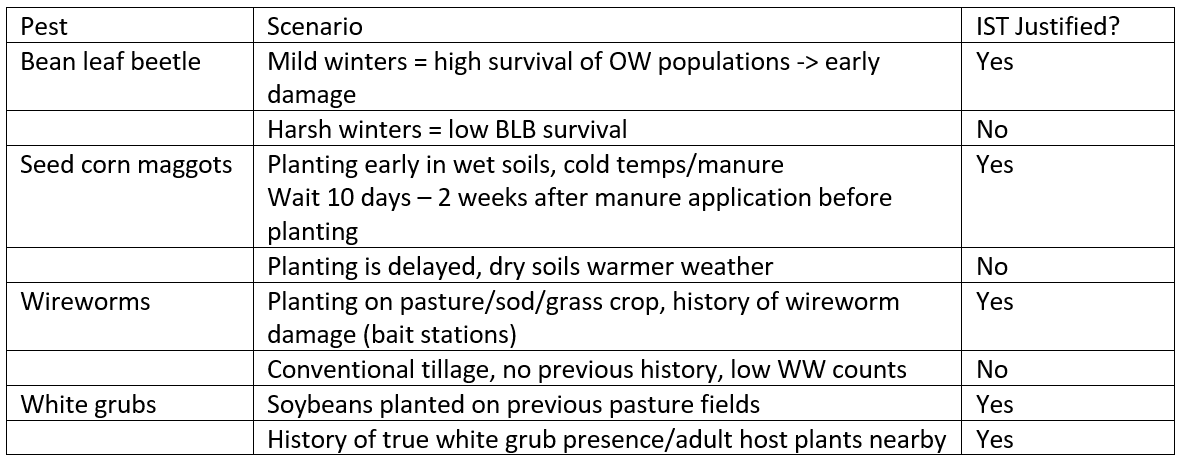ILSOYADVISOR POST
WEBINAR: Improving Yield Potential While Reducing Early Season Soybean Risk
Setting up the right environment for soybeans to flourish in the early stages of the life cycle is crucial to improving yield potential. In this webinar, Dr. Victoria Kleczewski will look at different early-season diseases and insects that can affect soybean yields later in the season and what proactive integrated pest management recommendations will optimize your soybean investment. Kleczewski will dive into seed treatments and how they can reduce financial and production risk while improving yield.
1 CEU in Integrated Pest Management
Presenter: Victoria Kleczewski, Insect and Plant Disease Technical Manager, GROWMARK, Inc.
- Fungicides
- Insecticides
- Nematicides – some fall into biologicals
- SDS
- Biologicals (Inoculants, stimulants, combination)
- Bean Leaf Beetles
- Key feature is the definitive triangle behind the pronotum
- Damage from feeding can lead to up to 12% yield damage
- Carriers of BPM virus – BPMV can lead to 3-50% yield reduction
- BPMV can also be transmitted by other insects like grape colaspis
- Overwinter as adults and different generations feed on seedlings and pods
- Seed treatments won’t control later-season beetles, but if we can decrease adults’ impact with treatment we can reduce overall number of beetles
- Harsh winters can result in significant levels of mortality – most will die in temperatures <14 degrees
- Grape colaspis: Corn and soybean grub
- Feeds on roots of corn and soybeans
- Damage looks like gaps in the rows, plants that came out of the ground and died
- Turn into beetles that don’t do a whole lot of damage, but will do a little bit of feeding on soybean leaves
- Will move out of corn fields to feed on soybeans
- Potential damage can be higher if you had higher pressure in previous year
- High rates of seed treatments needed to control this pest
- Seed corn maggot: fly that looks very similar to housefly
- Attracted to fields with manure, green vegetation and moist soils with high organic matter
- Flys will lay eggs that hatch into larva that look for seed to feed on – can kill plant altogether
- First generation can cause the most damage to soybeans and corn
- Cool temperatures in April and May
- Don’t have a rescue treatment for this pest – starts becoming active in low 40 degrees
- Wireworms: legless larva of click beetles
- Fields converted from pasture and soybeans planted after small grains are at higher risk
- Feed on seed germ of corn and soybeans – will tunnel into stem or root
- Plants will wither and die
- o Adult click beetles will not feed on crops
- Multi-year life cycles that last anywhere from 4-7 years – stay in larva stage for multiple years
- Move deeper into soil profile when temperatures warm up
- White grubs: pest of both corn and soybeans
- May beetle – 3 year life cycle
- Feed on roots – purplish stunted plants with low vigor
- No rescue – seed treatment is measure for control

- One chemistry available – neonicotinoids
- Soybean Seedling Blights – pathogens with a tail that makes it easy to swim – prevalent in wet conditions
- Phytophthora – more prevalent in warm temperatures
- Symptoms of brown discoloration from taproot to stem
- Pythium – more prevalent in cool temperatures
- Will see mushy decay seedling
- Dry rot – Rhizoctonia, Fusarium
- Variable in wet/dry conditions but like warm temperatures
- Symptoms of Rhizoctonia – reddish-brown lesions on stem and taproot
- Symptoms of Fusarium – lesions on taproot; shriveled and dry-rotted tissue
- Phytophthora – more prevalent in warm temperatures
- Sudden Death Syndrome
- Fusarium virguliforme – fungus that survives in soil and residue for years
- Likes cool, wet conditions and infect roots early
- Symptoms – root rot with blue colonies (take sample with soil moist)
- Fusarium virguliforme – fungus that survives in soil and residue for years
- Soybean Cyst Nematode
- Most impactful on soybeans – silent pathogen
- Can be present but may not see above ground symptom – usually only see symptoms when plant is under other stress
- Will see stunting, reduced nodulation – significant yield loss potential





Comments
Add new comment